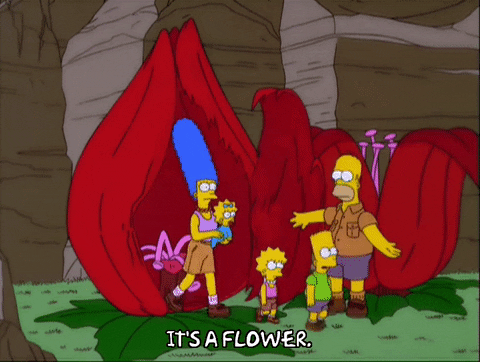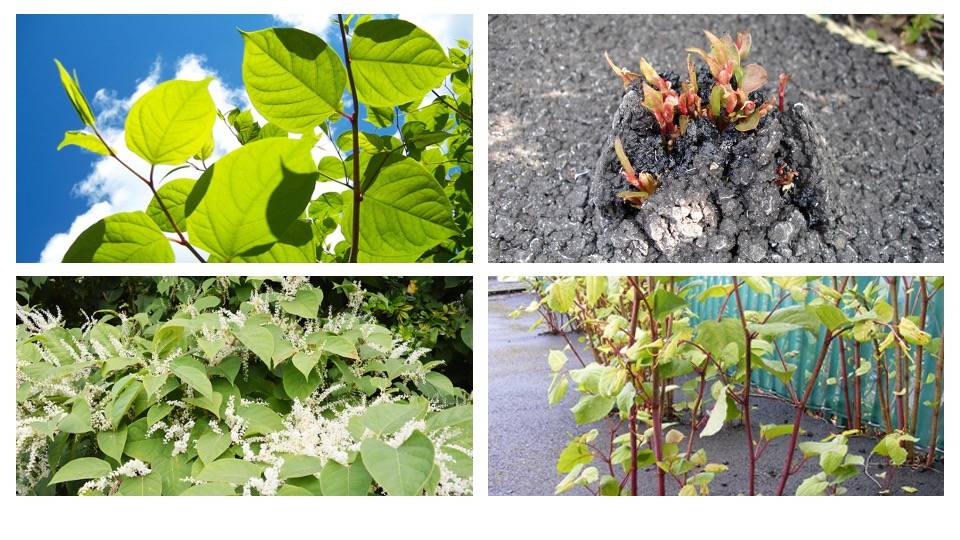Japanese Knotweed - What Is It and How to Deal with It?
All you need to know about Japanese knotweed
Japanese knotweed. You have probably heard of it, but what’s all the fuss? It’s just a plant, right? Well, no. The Environment Agency dubbed it “possibly the most economically important invasive non-native species in GB”. So, trowels down and eyes up Titchmarsh fans, this one’s important.
What does “herbaceous perennial” mean, I hear you shout. It’s a plant that dies down to ground level each year, but whose roots remain alive, sending up new growth each year – like Mariah Carey rising up each Christmas from wherever she hides for the other 11 months of the year.
It has stems that can be up to 2-metre tall and an extensive system of rhizomes. To those less versed in horticulture (like me), rhizomes are a mass of roots that grow underground and typically sideways, not straight down.
This extensive root system can also sprout new growth upwards. So, initially it might look like just one group of stems, but they could start sprouting all over the place in no time at all.
Japanese knotweed is the most common of four invasive knotweed plant species in the UK. The others are Dwarf knotweed (the small one), Giant knotweed (the big one) and Bohemian (hybrid) knotweed (the unconventional, artsy, eccentric one).

He, allegedly, found the plant growing on the side of a volcano near Nagasaki in Japan. He was studying Japanese flora and fauna to help the advancement of medicine. He was, and still is, highly commended for his work.
Victorian people of the mid-1800s were keen gardeners, always wanting to show off their gardens, hence horticulture was big business. Von Siebold collected over 1,000 species of native plants while in Japan in his garden there.
But (ominous music starts) one fateful day in 1850, one shipment of his Japanese native plants reached Kew Gardens. In this shipment was the first know specimen of knotweed to reach the UK.
People loved the plant for its heart-shaped leaves, quick growth (more on this later), and pretty white flowers. It was soon a must-have ‘ornamental architectural’ plant for any keen Victorian gardener and was regularly shared in the form of cuttings. It was first seen in the wild in the UK in 1886 in South Wales.
It is particularly good at growing in man-made habitats like roadsides, waste ground, railway embankments, and building sites with lots of earth moving and spoil tips.
Not-so-fun fact: All Japanese knotweed plants in the UK come from the same, female plant sent by Von Siebold in 1850. The male plant never made it here, and so it is, technically, all one plant!

In winter, the stems die back to ground level, but the dry / dead canes remain, looking like bamboo sprouting out of the ground.

It is often confused with other plants - like Himalayan honeysuckle and Russian vine, and so probably best to ask a professional if you suspect the dastardly weed. There are lots of companies who will identify it based on photos or conduct a home visit.
Read article
And herein lies the issue. It is described as a rapacious non-native invasive plant, basically meaning it grows very quickly and where you don’t want it to.
It is said to be able to grow through concrete and brick, though that hasn’t been proven. Due to its fast-growing and extensive root system, it can cause subsidence in properties – houses and garages alike – or block drains and sewage systems.
Due to this, it will often be noted in a survey when buying or selling a property. Its presence on a property can affect your ability to get a mortgage or significantly reduce the asking price of your property.
This is due to the possibility it is affecting the foundations of your property and the cost of treating, removing, and disposing of it.
So, who cares? It’s just a big, annoying weed that grows fast. Why bother checking? What you don’t know can’t hurt you, right?
Alas, due to knotweed’s invasive nature, the government stepped in, and it is a legal requirement to stop it from spreading.
If it is on your land, you do not have to remove it if it’s not a nuisance. However, you must stop it from spreading off your property and can be prosecuted for causing its spread in the wild.
BEWARE: If you have Japanese knotweed on your property, it is a legal requirement to stop it from spreading off your property.

Knotweed cuttings or waste are classified as controlled waste and require disposal at licenced landfill sites who are not going to let you in with a Citroen Saxo boot-full of Japanese knotweed offcuts!
BEWARE: Removing or treating Japanese knotweed should always be done by a professional. You can be prosecuted for not stopping it spreading or by causing the spread in the wild!
Whilst you shouldn’t try to get rid of it yourself, we know you’re curious – Professor Sprout would be proud, so here goes.
Read article

The big question that’s on your lips. As with everything like this, unfortunately – it depends. The deciding factor is the size of the area / plant to be treated or removed.
Looking at a few different sites for prices, a residential area of 20 sq. metres or less appears to vary between £500 and £2,000. It can be cheaper to treat the knotweed and hope it remains dormant, however, if its presence comes out in a survey when selling your property, it’s not good news.
To get an accurate price, you will need a survey from a company who can conduct the removal for you.
Read article
Also, to answer the question I know is first on your list – this article mentions ‘Japanese knotweed’ 41 times, including this one and the one in the URL.
Become a Host
Join thousands of Stashbee Hosts, start earning now
Become a HostWhat is Japanese knotweed?
Japanese knotweed (Fallopia japonica), or knotweed to the Japanese people, is a herbaceous perennial plant that is native to – you guessed it – Japan.What does “herbaceous perennial” mean, I hear you shout. It’s a plant that dies down to ground level each year, but whose roots remain alive, sending up new growth each year – like Mariah Carey rising up each Christmas from wherever she hides for the other 11 months of the year.
It has stems that can be up to 2-metre tall and an extensive system of rhizomes. To those less versed in horticulture (like me), rhizomes are a mass of roots that grow underground and typically sideways, not straight down.
This extensive root system can also sprout new growth upwards. So, initially it might look like just one group of stems, but they could start sprouting all over the place in no time at all.
Japanese knotweed is the most common of four invasive knotweed plant species in the UK. The others are Dwarf knotweed (the small one), Giant knotweed (the big one) and Bohemian (hybrid) knotweed (the unconventional, artsy, eccentric one).

How did Japanese knotweed get to the UK?
Philipp Franz von Siebold - a German physician, botanist and traveller born in 1796 – is generally credited (or perhaps accused) of introducing the Japanese knotweed to Europe.He, allegedly, found the plant growing on the side of a volcano near Nagasaki in Japan. He was studying Japanese flora and fauna to help the advancement of medicine. He was, and still is, highly commended for his work.
Victorian people of the mid-1800s were keen gardeners, always wanting to show off their gardens, hence horticulture was big business. Von Siebold collected over 1,000 species of native plants while in Japan in his garden there.
But (ominous music starts) one fateful day in 1850, one shipment of his Japanese native plants reached Kew Gardens. In this shipment was the first know specimen of knotweed to reach the UK.
People loved the plant for its heart-shaped leaves, quick growth (more on this later), and pretty white flowers. It was soon a must-have ‘ornamental architectural’ plant for any keen Victorian gardener and was regularly shared in the form of cuttings. It was first seen in the wild in the UK in 1886 in South Wales.
It is particularly good at growing in man-made habitats like roadsides, waste ground, railway embankments, and building sites with lots of earth moving and spoil tips.
Not-so-fun fact: All Japanese knotweed plants in the UK come from the same, female plant sent by Von Siebold in 1850. The male plant never made it here, and so it is, technically, all one plant!
How does Japanese knotweed spread?
There are two main ways Japanese knotweed spreads:- As mentioned above, its rhizomes or root systems grow sideways and can shoot upwards to produce a new clump of stems
- It can also spread easily from cuttings or contaminated topsoil where the plant has grown previously. Hence why it is treated as controlled waste!

What does Japanese knotweed look like?
A picture speaks a thousand words, right? So, see below for some photos. But to spell it out a bit:Japanese knotweed roots and stems
Japanese knotweed begins its annual growth with reddish-purple shoots from pink buds at ground level. The stems grow very quickly from here in summer up to two metres in height with characteristic purple flecks and branches emerging from nodes along the stem’s length.In winter, the stems die back to ground level, but the dry / dead canes remain, looking like bamboo sprouting out of the ground.
Japanese knotweed leaves
Knotweed is described as having ‘heart or shovel-shaped’ green leaves up to 14-cm in length and forming a zig-zag pattern along the stem.Japanese knotweed flowers
In late summer to early autumn, it produces creamy-white flowers in tassels up to 15-cm long.
How to identify Japanese knotweed?
Unfortunately, the above is a relatively non-descript description because lots of plants look like that. Hence why there are specialists who identify it for you!It is often confused with other plants - like Himalayan honeysuckle and Russian vine, and so probably best to ask a professional if you suspect the dastardly weed. There are lots of companies who will identify it based on photos or conduct a home visit.
Related
How to Organise Your Garden Tool Storage: Tips and Tricks
Why is Japanese knotweed bad?
OK, from here on out, this isn’t as fun – more of a horticultural horror story. As the keen-eyed amongst you may have noticed above, one of the properties of Japanese knotweed is its fast growth.And herein lies the issue. It is described as a rapacious non-native invasive plant, basically meaning it grows very quickly and where you don’t want it to.
It is said to be able to grow through concrete and brick, though that hasn’t been proven. Due to its fast-growing and extensive root system, it can cause subsidence in properties – houses and garages alike – or block drains and sewage systems.
Due to this, it will often be noted in a survey when buying or selling a property. Its presence on a property can affect your ability to get a mortgage or significantly reduce the asking price of your property.
This is due to the possibility it is affecting the foundations of your property and the cost of treating, removing, and disposing of it.
So, who cares? It’s just a big, annoying weed that grows fast. Why bother checking? What you don’t know can’t hurt you, right?
Alas, due to knotweed’s invasive nature, the government stepped in, and it is a legal requirement to stop it from spreading.
If it is on your land, you do not have to remove it if it’s not a nuisance. However, you must stop it from spreading off your property and can be prosecuted for causing its spread in the wild.
BEWARE: If you have Japanese knotweed on your property, it is a legal requirement to stop it from spreading off your property.

How to get rid of Japanese knotweed?
There are two main ways to go about this: 1) treat the knotweed and stop it spreading; or 2) kill and dispose of it permanently. This should always be done by a professional because treating it requires hazardous chemicals.Knotweed cuttings or waste are classified as controlled waste and require disposal at licenced landfill sites who are not going to let you in with a Citroen Saxo boot-full of Japanese knotweed offcuts!
BEWARE: Removing or treating Japanese knotweed should always be done by a professional. You can be prosecuted for not stopping it spreading or by causing the spread in the wild!
Whilst you shouldn’t try to get rid of it yourself, we know you’re curious – Professor Sprout would be proud, so here goes.
Related
Where to Start Tidying Up a Messy Garden
How do you treat Japanese knotweed?
The main treatment professionals use to stop Japanese knotweed spreading is by spraying or injecting chemicals, however you can only use approved herbicides. It can take up to three years to treat Japanese knotweed roots which can lay dormant for years, only to spring back into life if disturbed.
How to kill Japanese knotweed?
Your professional knotweed specialist will assess, dig and expose the full plant, before taking away and disposing of it in a licenced landfill site. Knotweed can also be burned and buried on site; however, knotweed crowns and roots can survive burning.Japanese knotweed removal cost?
The big question that’s on your lips. As with everything like this, unfortunately – it depends. The deciding factor is the size of the area / plant to be treated or removed.
Looking at a few different sites for prices, a residential area of 20 sq. metres or less appears to vary between £500 and £2,000. It can be cheaper to treat the knotweed and hope it remains dormant, however, if its presence comes out in a survey when selling your property, it’s not good news.
To get an accurate price, you will need a survey from a company who can conduct the removal for you.
Related
How to Make Your Garden Sustainable
Who should I get to remove the knotweed?
When searching for a professional, look for the following accreditations, regulations and bodies:- Amenity Forum Membership
- BASIS Professional Register
- BASIS Amenity Training Register
- BASIS Nominated Storekeeper (NSK) Professional Register
- Invasive Non-Native Specialists Association (INNSA)
- Property Care Association (PCA)
Also, to answer the question I know is first on your list – this article mentions ‘Japanese knotweed’ 41 times, including this one and the one in the URL.
Useful articles
Become a Host
Join thousands of Stashbee Hosts, start earning now
Become a HostElliot
Written 14th Apr 2023
